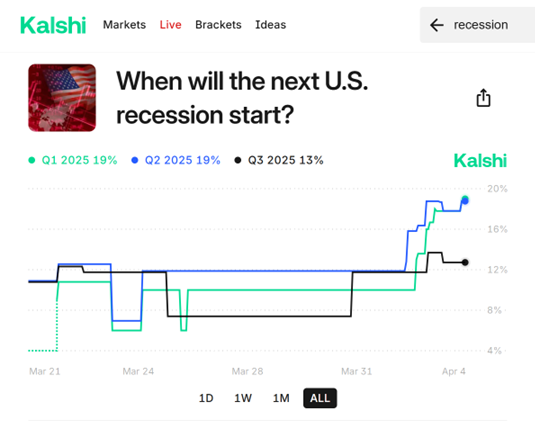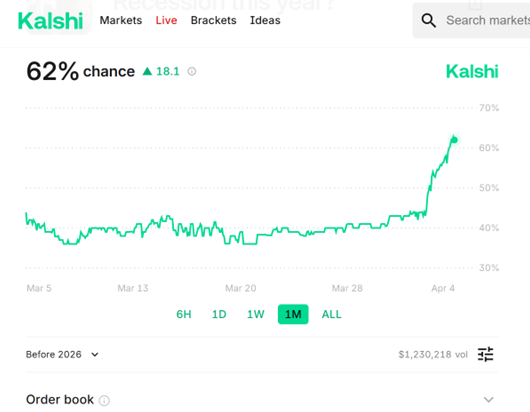Even if the answer is yes, we won’t know for a long time.
Here’s the odds on the recession start, with Q1 at 19%, same for Q2:
Combining with the probability of recession in 2025:
Between the two sets of betting odds, a recession start in Q4 has 11% probability.
Note we only have preliminary employment numbers for March, and non for other key indicators followed by the NBER BCDC. On the basis of those numbers, NBER BCDC would be unlikely to start date to March (although March could still be a “peak” month in the NBER chronology).


One thing we know about since the mid-March payroll survey is that new claims are looking quite tame, while continuing claims just rose to the highest level since November 2021. The rise in continuing claims has been gradual, a sign of the steady cooling in the labor market.
High continuing claims and low new claims means a slowdown in hiring and firing. That’s consistent with a late-cycle economy, and with what the JOLTS data show. So as of late March, just after March payroll data were collected, we’re seeing labor market data that isn’t showing evidence of a shock.
Labor data tend to lag, so other than the direct effects of government layoffs, we shouldn’t be surprised that labor data haven’t changed much; the shock is still to come. ISM data, orders data, financial market data, consumer discretionary spending – these are the sorts of things to watch for early signs of a shock.
As to that shock, here’s Powell’s comment today:
“While tariffs are highly likely to generate at least a temporary rise in inflation, it is also possible that the effects could be more persistent. Avoiding that outcome would depend on keeping longer-term inflation expectations well anchored, on the size of the effects, and on how long it takes for them to pass through fully to prices.”
Tightening words? I’d think so, but market pricing has pulled Fed easing ever-so-slightly forward, perhaps because the S&P has lost another 5% today – no short-covering yet. (See yesterday’s comment from PoppingMyStitches.) The VIX is now at its highest level since early 2021, not conducive to dhort-covering.
Credit spreads, while not yet dire, are widening pretty quickly. The Fed is very sensitive to credit-market conditions. This is also the kind of situation in which financial plumbing problems can crop up. Bessent has shown himself to be willing to say stupid stuff, but we don’t know yet whether he’s actually stupid or how he’ll respond in a crisis. Luckily, the Fed is still in professional hands.
Sure would be nice to have Yellen around.
“The S&P’s 9% loss since last Friday makes this stocks’ worst week since March 2020 and the fifth-worst week of the last 20 years, trailing only losses sustained in October 2008 and early 2020.”
https://www.forbes.com/sites/dereksaul/2025/04/04/tariffs-cause-another-stock-market-rout-losses-approach-5-trillion-as-dow-plummets-another-2200-points/
The stock market is not the economy. The Fed is much more sensitive to credit-market developments than to stock-market performance. Over-valuation may have led to a sharper stock market response, relative to underlying fundamentals, than in earlier episodes. Those things said, the stock market does give a sort of one-stop market assessment of new developments, and the judgement is dire.
In those earlier episodes, financial markets began to crack, and emergency measures had to be taken. I’ll be keeping an eye on the weekend and Monday financial press for cracks.
The S&P 500 is now down YoY, which satisfies one of the two criteria for my “quick and dirty” recession model.
The other part is the four week average of initial claims, which is currently higher by 3.4%. For a reliable signal, it has to be at least 10% higher. Surely just a couple of weeks’ work for the Magnificent Mister T—-p.
After a quick glance at the appropriately jiggered chart of initial claims, my impression is that the rise from 3.4% to 10% can happen in short order. In 1989-1990, it took about a year. Ahead of other recessions, it happened more quickly.
My worries about cracks in our financial plumbing should be soothed somewhat by the fact that Fed policy has not been accommodative, so leverage should be limited, right? Um…well…while that’s certainly true in the abstract, in fact financial leverage is pretty high.
For private equity, which can be thought of as leveraged equity, assets under management have risen from $440 billion in December 2020 to $3.1 trillion in October 2024:
http://www.spglobal.com/market-intelligence/en/news-insights/articles/2025/4/us-private-equity-aum-hits-3128-trillion-in-2024-88099590
Margin debt, at 3.09% of GDP, is high, though not at a record:
http://www.gurufocus.com/economic_indicators/4266/finra-investor-margin-debt-relative-to-gdp
The immediate concern is equity market leverage, given that it is the equity market that was chewing its own leg off this week. One glimmer of good news is that margin positions were trimmed in February.
However, financial leverage overall is the greater concern when leverage begins to contract, as seems fairly likely in the near term. For starters, higher recession risk means banks will need to raise loan reserves, and that means tighter credit.
Leveraged loans outstanding at the end of 2024 totaled $1.337 trillion, up from 2023’s $378 billion. The previous record of $985 billion in 2017:
http://www.fitchratings.com/research/corporate-finance/leveraged-loan-market-breaks-records-with-trillion-dollar-milestone-in-2024-31-01-2025
Swap spreads are also showing signs of stress. The 2-year spread narrowed by 4 basis points to -23 today, the biggest single-day move since regional bank wobbles in March, 2024.
http://www.kitco.com/news/off-the-wire/2025-04-04/market-warning-lights-flash-amber-after-trump-tariff-shock
And what do you know, margin calls on gold are in the news, with forced selling part of the story:
https://www.fxempire.com/forecasts/article/gold-xauusd-price-forecast-margin-calls-trigger-liquidation-is-3000-the-next-target-1509453
Even Bloomberg’s editors see a problem:
http://www.bloomberg.com/opinion/articles/2025-04-04/shadow-banks-need-to-be-prepared-for-the-unexpected
So anyhow, leverage is fairly high, the motive to reduce loan exposure is high, and asset values are falling. That’s a pretty standard formula for marginal calls and a downward spiral. Liquidity problems crop up in downward spirals.
Here’s a little something for grad students looking for a way to get at tariff effects:
https://www.carscoops.com/2025/03/how-much-of-your-car-is-really-made-in-the-usa/
It’s a table showing domestic content by make and model of cars sold in the U.S. Comparing the price change of a high-domestic-content vehicle to that of a very similar low-domestic-content vehicle could be revealing, as could comparisons of changes in numbers of vehicles produced.
By the way, the highest domestic-content vehicle is the Kia EV6, at 80%. The F150 is at 45%. The Chevy Trailblazer comes in at 3%. In general, Acuras and Hondas have higher domestic content that Fords and Chevys. Should make for interesting shopping.
After several chats with AI, I thought the following was instructive as related to the tariff mess we currently have. Perhaps a way out through negotiating.
Title: Toward Fair and Reciprocal Trade: A Call for WTO Reform
Introduction: The Need for Equity in Trade
Highlight the importance of fair trade in fostering global economic stability and equitable growth.
Acknowledge past successes of the WTO while identifying shortcomings, particularly around asymmetric tariff policies among developed nations.
The Problem: Uneven Tariff Policies
Use the example of automotive trade (e.g., Asian countries with high tariffs on U.S. vehicles while accessing the U.S. market with minimal barriers).
Emphasize the impact on domestic manufacturing, middle-class jobs, and the social fabric, particularly in the U.S.
Proposed Solution: Rational and Transparent Tariff Framework
Suggest a WTO-based mechanism for evaluating tariff needs:
Developing countries could apply for temporary, time-bound tariff protections to nurture specific industries.
Developed countries, however, would adhere to reciprocal zero-tariff agreements in sectors where they are already globally competitive.
Introduce a framework to regularly review the necessity of these tariffs with clear benchmarks for economic progress and global market integration.
Enforcement and Incentives
Advocate for stricter WTO enforcement mechanisms to discourage unjustified protectionist policies.
Propose trade incentives for nations that adopt reciprocal tariff reductions, such as access to global development funds or trade benefits.
Rebuilding Manufacturing in the U.S.
Tie the reform to domestic policies aimed at revitalizing American manufacturing:
Investment in advanced manufacturing technologies.
Workforce retraining programs for displaced workers.
Tax incentives for companies that reshore production.
Closing Thoughts: Balancing Globalization with Fairness
Recognize the challenges of navigating global cooperation but stress the necessity of reforms to rebuild trust, fairness, and equity in international trade.
Don’t we already know the cracks with Fink (securitization and derivatization genius) begging for 401k bailout into private equity? Asking for a friend.